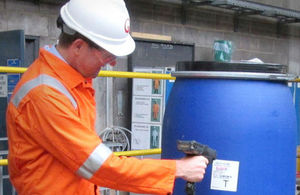UK completes incineration of Syrian chemicals
FCO Minister welcomes international cooperation on destruction of Syrian chemical components; underlines need for international unity to end the appalling conflict.

Today marked the completion of incineration at Ellesmere Port of around 190 tonnes of Syrian chemical material, intended for use by the Assad regime to manufacture nerve agent.
As previously announced, the UK agreed to destroy approximately 15% of the total declared Syrian chemical stockpile in commercial facilities. The entire stockpile of one category of chemicals, known as “B precursors”, along with a smaller volume of hydrochloric acid also from the Syrian chemical weapons programme, arrived in Britain three weeks ago. The chemicals were then transferred to the High Temperature Incinerator operated by Veolia at Ellesmere Port, where they have been destroyed, under the verification procedures of the Organisation for the Prohibition of Chemical Weapons (OPCW), ending the company’s involvement in this task.
Minister for the Middle East and North Africa, Tobias Ellwood, said:
By destroying these chemicals, the United Kingdom has played its part in the international effort to ensure that Assad’s chemical weapons can never again be used against the Syrian people. The removal, and now the destruction in four countries, of the declared Syrian chemical stockpile show what can be achieved when the international community, including Russia, agrees to work together for the common good.
The challenge remains to bring that same unity to bear in securing a political settlement to end this appalling conflict. Such a settlement is all the more urgent as the conflict continues to claim hundreds of lives each month, despite the efforts of the moderate opposition to protect the Syrian people from both Assad and extremists.
Completing destruction of the declared stockpile does not mark the closure of the chemical weapons chapter. Gaps and inconsistencies in Syria’s declaration need to be resolved. There continue to be credible reports of attacks using industrial chemicals such as chlorine. The OPCW Fact Finding Mission’s interim conclusions stated that the available information lent credence to the view that these attacks were being systematically orchestrated. The Mission must leave no stone unturned in its investigation, and the perpetrators of such barbaric acts must be held accountable.
The work at Ellesmere Port is part of international efforts involving destruction facilities in the USA, Finland and Germany and with support from many other states and the OPCW. The destruction by neutralisation of a smaller volume of hydrogen fluoride will take place towards the end of the year. This will complete the UK’s role in destruction activities.
Further information
- The B precursors are two industrial grade chemicals which if combined with chemicals known as A precursors produce nerve agent. As a safety and security precaution, the type A and type B precursors were never transported by the OPCW together.
- The UK offered in December to destroy the entire batch of B precursors on behalf of the OPCW, using an existing MOD contract with Veolia. Subsequently, the OPCW requested the UK destroy an additional 44 tonnes of hydrochloric acid and six tonnes of hydrogen fluoride. The completion of incineration operations marks the end of Veolia’s involvement with this task.
- The hydrogen fluoride is not suitable for incineration by Veolia and will instead be chemically neutralised by a second UK business. This work should be completed around the turn of the year.
- The chemical stockpile declared by the Assad regime comprised some 1300 tonnes. Part of the remainder is being destroyed at commercial facilities in Finland and the United States, whilst the chemicals posing the greatest concern are first being hydrolysed at sea aboard the US ship Cape Ray. The resulting less harmful effluent will then be destroyed in Germany and Finland.
- The effort to remove the Syrian chemical stockpile has been led by the OPCW, with significant contributions from several nations. Denmark and Norway led the maritime task force which transported the chemicals out of Syria; Russia and China contributed naval escorts needed for security off the coast of Syria; the Royal Navy also provided naval protection in the eastern Mediterranean; Finland provided specialist technical expertise; Italy provided a port for transhipment of material; and the USA, Germany and Finland are all contributing to the subsequent safe handling and destruction of the chemicals.
- Imagery – stills and video – of the arrival of the chemicals at Marchwood Military Port on 15 July can be downloaded here. The pictures show the Danish vessel Ark Futura being unloaded by soldiers from 17 Port & Maritime Regiment, assisted by experts from Veolia, and verification by the OPCW inspection team.
Follow the Foreign Office on twitter @foreignoffice
Foreign Office Minister Tobias Ellwood on twitter @TobiasEllwoodMP